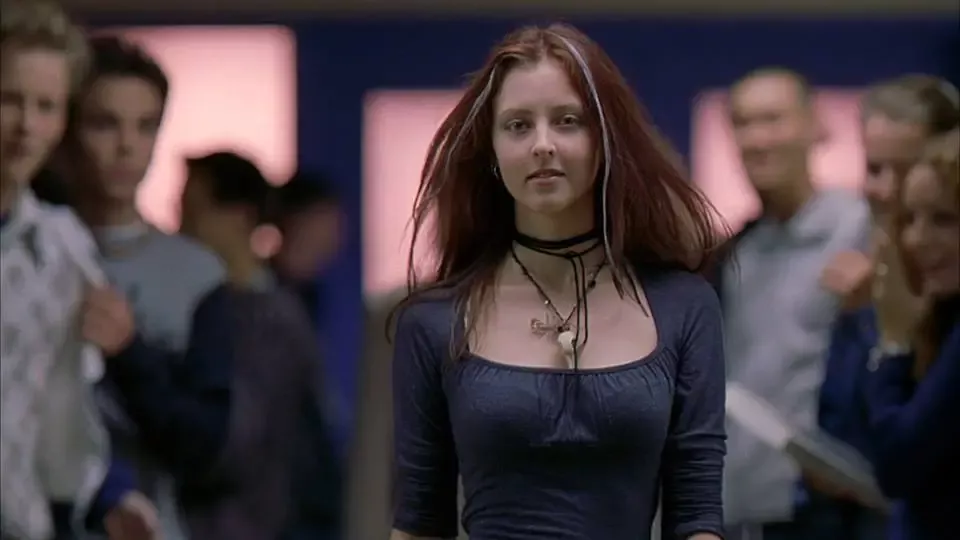Why are women and monsters so intertwined in our media? Witches, succubi, sirens, harpies, all of these forms of monsters are primarily presented as both creature and woman, often as a paradox of beauty, desire, and fear. But what remains the most interesting element is the strong connection that many women feel with the monster. Women can sympathize with monsters and their transformations because of the change from “girl” to “thing” experienced throughout puberty. A transition where girls are no longer seen as human. Girls become the other to themselves and an object of lust and fear to everyone else.
John Fawcett’s 2000 film Ginger Snaps draws this line between girl and monster by connecting the transformation of the werewolf to puberty through one of the lead characters, Ginger Fitzgerald.

Sisters Ginger and Brigitte have an intense fascination with death, murder, and torture and show this through varying photographs they submit as a school project. The images of suicide, murder, and gruesome accidents they compile elicit a reaction of disgust from the teacher. However, our main ‘antagonist’ or ‘prey’ for Ginger, and the head misogynist among the boys, Jason, comments: “Hey, can we see the ones of Ginger again?” leading into a few wolf whistles. Again, these are images of her bloody, lifeless body. As opposed to the disgust shown by Brigitte, Ginger looks slightly pleased with the moment of male attention, regardless of context. Already, the idea of women being tied to pain is presented in a callous way, while not being the focus or concern.
The experience of a first period is an intense point of change that both Ginger and Brigitte fight against, even going as far as to name it “the curse.” The signs of growing into a woman are something to fear for the two, not without reason. The boys they go to school with constantly make sexual and misogynistic comments about girls’ bodies. Since we are told that both Ginger and Brigitte are late in getting their periods, we can assume that the other girls have already gone through puberty. Both girls have seen these behaviors from an outside perspective, but they are unfamiliar with the direct male gaze. They also place themselves in the “I’m not like other girls” category. They take pride and pleasure in being the odd ones out, often slighting other girls. They have linked their internalized misogyny to periods and fear its existence will transform them into the girls they insult. “Tell yourself to be different and your own body screws you,” Ginger intensely puts it.

The idea of Ginger getting her period soon is brought up many times, mostly by her mother, but the moment it begins, she is dragged away into the woods by a werewolf. A violent and monstrous attack on her body eventually transforms it into something unrecognizable. The event is bloody and brutal, leaving both Ginger and Brigitte panicked over how this would impact Ginger. Lines between the lore of the werewolf and puberty blur when Ginger becomes more aggressive, with borderline animalistic mood swings and an increased sex drive. She becomes more “bitchy” or manipulative towards her family and peers. There’s even a tongue-in-cheek jab at the idea of puberty and werewolves becoming one when Brigitte asks the school nurse about hair growing in new places because Ginger has started to grow tufts of wolf hair out of the claw marks on her shoulder.
And, of course, there’s also the classic “monster made me hot” effect. Once Ginger recovers from the werewolf attack, a noticeable change in attitude and appearance emerges. She begins to wear tighter clothes meant to accentuate her figure and darker, more noticeable makeup. When she walks down the hallway, everyone either looks at her with envy or arousal. She starts dating main misogynist Jason and actively wants to become part of popular groups that she and Brigitte swore they would never understand the appeal of. This sequence of “monster made me hot” is like the peak before the crash. She’s gaining attention she’s never had before with sexual undertones that she no longer finds unwanted or irritating but, rather, exciting.
Then comes the crash. A fear of the body becomes a large theme within the second act as Ginger starts to appear more like a werewolf. Her teeth and nails sharpen, she begins to grow a tail, and her nose and eyes become more wolf-like than human. Her body is changing quickly into something that is not fully hers anymore. I viewed this fear as both of the physical changes and the idea of realizing that, at a certain point, a woman’s body does not fully belong to her anymore. It’s now available for scrutiny based on how she uses it or presents it. When Ginger describes her first time having sex, she says she knows Jason is probably out telling all his friends what a freak she is. Brigitte says they will do the same but Ginger comments, “It doesn’t work like that.” Later she’ll go on to say, “Trust me, a girl can only be a slut, bitch, tease, or the virgin next door. We’ll just coast on how the world works.”
That iconic bite symbolizes the fear of changes and the natural cultural pressures that appear when girls start to become women. These shifts force them to feel they have become “the other” to themselves based on society’s rules. Ginger had sex and now realizes “a lay” is the title she got out of it. Even if she wasn’t becoming a werewolf she sees her role in the world has shifted. Much like puberty or a wild werewolf attack, it’s something out of her control.
Ginger is a paradox: woman and monster, natural and supernatural, wanted and feared. “A goddamn force of nature.”
Comments